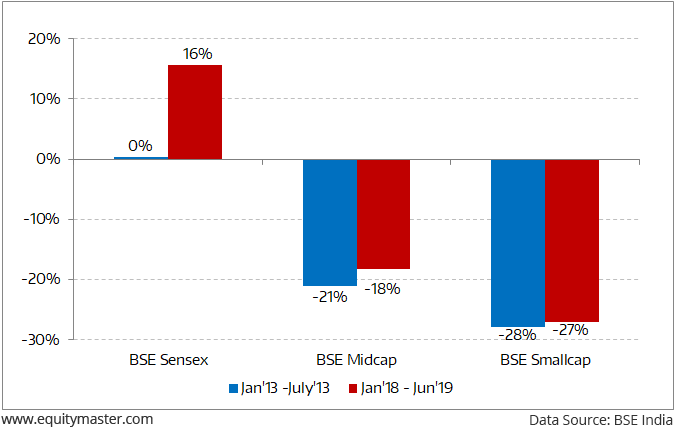India's Third Giant Leap
This Could be One of the Biggest Opportunities for Investors
- Home
- Todays Market
- Indian Stock Market News July 5, 2019
Sensex Opens Above 40,000-Mark ahead of Budget 2019; Realty Stocks Gain Fri, 5 Jul 09:30 am
Asian share markets are lower today as Japanese and Hong Kong shares fall. The Nikkei 225 is off 0.1% while the Hang Seng is down 0.1%. The Shanghai Composite is trading down by 0.2%. US stocks rose on Wednesday, with each of the major indexes closing at a record high, as expectations grew that the Federal Reserve would take a more dovish turn as a raft of data provided more evidence of a slowing economy.
Back home, India share markets opened the day on a positive note. The BSE Sensex is trading up by 111 points while the NSE Nifty is trading up by 30 points. Both, the BSE Mid Cap index and BSE Small Cap index opened up by 0.1%.
Sectoral indices have opened the day on a mixed note with telecom stocks and metal stocks leading the losers. Capital goods stocks and realty stocks have opened the day in green.
Speaking of stock markets, the current pattern of the Indian stock market very closely resembles 2013.
Back then too, Sensex was relatively flat while mid and small caps underperformed by a huge margin.
Only this time, the divergence is larger.
How Long Will this Sensex Outperformance Last?
While the 2013 correction was due to global macro issues, the correction in mid and small caps are due to factors back home.
Corporate governance issues leading to auditor exits plagued many mid and small caps in 2018. Then, we had the IL&FS impact leading to the NBFC crisis.
Will this Sensex outperformance continue?
Co-head of research, Tanushree Banerjee believes it will be difficult going forward. Here's an excerpt of what she wrote:
- "But when I think of safe stocks, I think long-term about the businesses rather than how the Sensex will perform.
I think of businesses that will be a part of India's long-term growth story. I strongly believe these businesses stand to do well irrespective of the movement of the Index."
Moving on, the rupee is currently trading at 68.86 against the US$.
The Indian rupee on Thursday furthered its gains by another 39 paise to 68.50 a dollar, tracking firmer emerging market currencies, lower crude oil prices, even as participants keenly awaited the Union Budget to be unveiled today.
At the forex market, the rupee opened at 68.86 per dollar and advanced to a high of 68.49 during the day. It finally settled at 68.50, up 39 paise against its previous close of 68.89.
Meanwhile, the Economic Survey 2019 stressed the need to give a huge boost to spending and reforms to accelerate higher rate of expansion to double the economy's size to US$5 trillion by 2024-25.
Reportedly, the budget will give further cues going ahead in the currency market.
Meanwhile, in this latest video below, Rahul Shah shares an important investment lesson before making a big bet on the Union Budget 2019.
Moving on to the news from the mutual funds space. Mutual funds' asset base increased to Rs 25.5 trillion in April-June 2019, a rise of 4.1% over the previous quarter, on the back of increased retail participation.
The asset base of the industry, comprising 44 players, stood at Rs 24.5 trillion in the preceding three months, according to data by the Association of Mutual Funds in India (AMFI).
In recent months, the mutual fund industry has been grappling with redemption pressures in the wake of debt crises at various groups, including IL&FS, Essel and DHFL.
Fund managers said apart from more retail participation, rise in equity markets as well as inflows in money market funds led to the rise in assets under management (AUM).
The total asset base of the industry was Rs 23 trillion in the same period a year ago.
Of the 44 fund houses, as many as 24 witnessed growth in their asset base during the period under review as compared to the January-March quarter.
DHFL Pramerica Mutual Fund, Essel Mutual Fund and DSP Mutual Fund were among the fund houses that saw a decline in their AUMs.
In terms of asset size, HDFC MF continued to lead the pack with an AUM of Rs 3,625.4 billion (excluding fund of funds) at the end of the June quarter, followed by ICICI Prudential MF (Rs 3,372.9 billion) and SBI MF (Rs 3,075.3 billion).
In a statement, SBI Mutual Fund said it is number one in terms of AUM addition, which rose by Rs 237.2 billion in the period under review.
To know what's moving the Indian stock markets today, check out the most recent share market updates here.
For information on how to pick stocks that have the potential to deliver big returns, download our special report now!
Read the latest Market Commentary



Equitymaster requests your view! Post a comment on "Sensex Opens Above 40,000-Mark ahead of Budget 2019; Realty Stocks Gain". Click here!
Comments are moderated by Equitymaster, in accordance with the Terms of Use, and may not appear
on this article until they have been reviewed and deemed appropriate for posting.
In the meantime, you may want to share this article with your friends!